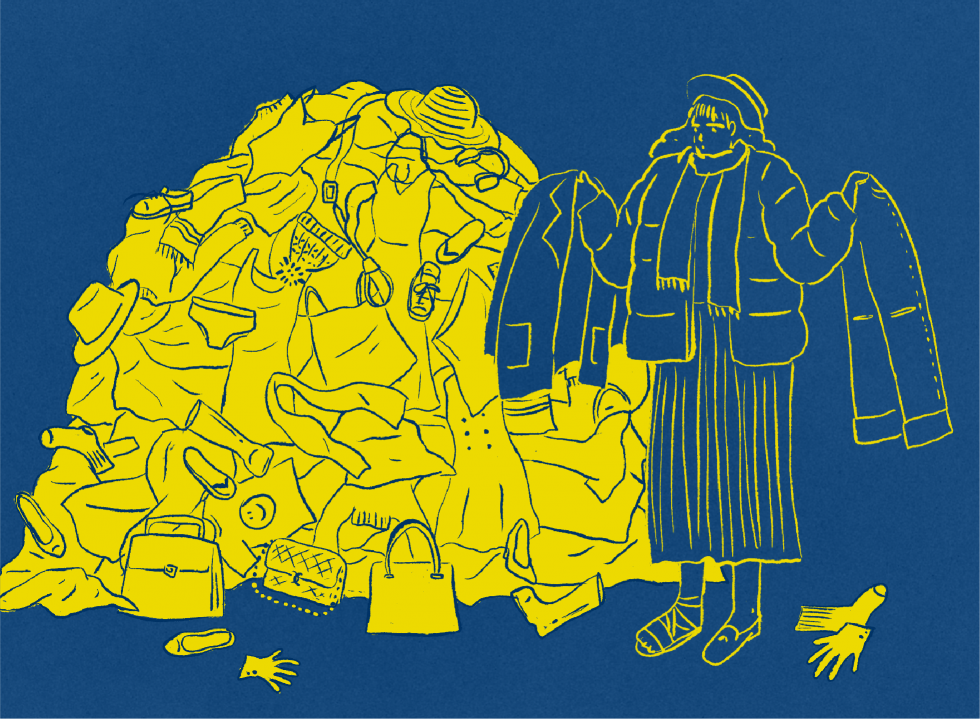In our effort to make social distancing less monotonous, REMOTELY is a special series from Manual Jakarta where we roll out comforting and practical articles to keep you company and motivated during this period of self-isolation.
—
With self-quarantine in effect, the amount of spare time we have at home is frequently met with various self-fulfilling activities; from discovering new music, binge-watching, learning how to cook, reading that one book we never finish to partaking in virtual workout classes—the list can go on.
Unlike these recreational endeavours, spring cleaning is one that not many may choose to engage. But the ‘chore’, as tedious as it can be, is anointed with merits beyond freeing our closet space: it’s an art and tradition of decluttering that fosters mental health benefits with an opportunity to do good. Instead of thinking of the practice as a burden, we count on these up and thriving fashion figures for their perspectives on how spring cleaning goes beyond a ‘seasonal’ routine that “sparks joy”—as Marie Kondo knows best.
Toton Januar, fashion designer
We call it spring cleaning because it’s done once a year during the said season. But really, how often should we actually spring clean in a year?
TJ: Maybe once a year? At first, I felt like I was forced to do it. I have to confess that I am actually a bit of a hoarder who loves to buy ‘unnecessary’ things. This could be a problem due to the limited space I have.
Other than the obvious (decluttering your belongings), what are other benefits to spring cleaning?
TJ: When you’re done decluttering, you’ll see a ‘map’ to your belongings in terms of functionality, aesthetics, and how they make you feel. It’s beneficial for its helpful merit which indicates how much they (your belongings) mean to you.
What are your tips to make spring cleaning fun and hassle-free?
TJ: I think Marie Kondo nailed it when she said to keep things that spark joy to you.
What are the questions we should ask ourselves to decide between keeping and tossing?
TJ: Do I need it? Do I want it? Is it useful? Does it still inspire me? Prioritise the things that you often use, but not too often for it might be overused already.
Finally, what are your suggestions on what to do with the clothes that are tossed out? (Stash or Donate)
TJ: Goodwill. Give it to people in need. Or if it’s a vintage piece, you can always resell it. But if you have a crafty inclination, you can always recycle or repurpose them.
Emmelyn Gunawan, founder of Canaan Studio and Niniveh
We call it spring cleaning because it’s done once a year during the said season. But really, how often should we actually spring clean in a year?
EG: As often as you feel your wardrobe is overflowing. For me, I always know when I feel like there’s an overflow of clothing and when my space feels a bit overwhelming.
Other than the obvious (decluttering your belongings), what are other benefits to spring cleaning?
EG: I definitely feel like it affects your mood; the air is cleaner, there’s more room to breathe and visually, everything looks more orderly.
What are your tips to make spring cleaning fun and hassle-free?
EG: Set the mood with a playlist that relaxes you. When I’m doing the whole regimen, I like to diffuse essential oils or light a few scented candles.
What are the questions we should ask ourselves to decide between keeping and tossing?
EG: I think about whether there’s someone who can benefit more if I give these items to them, also how often do I actually use or wear it. And most importantly, how sentimental this item is to me.
Finally, what are your suggestions on what to do with the clothes that are tossed out? (Stash or Donate)
EG: We live in a country or environment where there are many disadvantaged communities around us. I usually start with the people closest to me, my helpers, and their family. Also, I have employees and their family, so I also give [my belongings] to them. I definitely prefer to donate rather than stashing it.
Intan Anggita, co-founder of Setali Indonesia
We call it spring cleaning because it’s done once a year during the said season. But really, how often should we actually spring clean in a year?
IA: We usually do a thorough cleaning once a year, just like spring cleaning, but I say it’s better to do it every three months. We must declutter our belongings to refresh our closet since it affects our mood in a way. With all the materialistic values within our unused belongings, giving them away or donating them will inadvertently teach us about the art of giving. The stuff that we’re giving away may “spark joy” to us, but it’s necessary for us to be aware that others might need this stuff more than we do. [Spring cleaning] means a lot to our mental health and it will leave us feeling good and relieved.
Other than the obvious (decluttering your belongings), what are other benefits to spring cleaning?
IA: As I said before, it is beneficial for your mental health. Collecting stuff as a hobby is good, but if you collect too many and end up not using them, the problem isn’t with the stuff that you bought, but with you. Either give it or donate it.
What are your tips to make spring cleaning fun and hassle-free?
IA: Treat it as a game to which you reward yourself when you succeed. Spring cleaning is not easy. You must have a big heart (and patience) for sorting out stuff and decide how you treat them next.
What are the questions we should ask ourselves to decide between keeping and tossing?
IA: Are you comfortable and do you still have chemistry with them (or the items)? Like Marie Kondo said; spark joy is a must.
Finally, what are your suggestions on what to do with the clothes that are tossed out? (Stash or Donate)
IA: On behalf of Setali, I suggest you donate, because we specialise in making rather than prolonging and making sustainable movements like upcycling. The landfill is not our destination.
Allysha Nila, fashion writer and stylist
We call it spring cleaning because it’s done once a year during the said season. But really, how often should we actually spring clean in a year?
AN: Three or four times a year. That way you don’t have a mountain to work with. Besides being more sanitary, you won’t have to mentally compute as much if you don’t organise stuff methodically. I’m not suggesting you go full-on Marie Kondo, but I’m saying that we should prevent that scenario by doing a thorough clean more often. That way you can work on different parts of the house as opposed to being overly ambitious and do everything at one go.
Also, spring cleaning shouldn’t be limited to your home—most people forget about their workspace. When you work in media, you get a ton of press kits and gifts. If you don’t do that spring cleaning quarterly, your office is going to induce claustrophobia by having lots of “outdated” stuff nobody really asked for.
Other than the obvious (decluttering your belongings), what are other benefits to spring cleaning?
AN: Your physical space affects your mental space. If you clean your bedroom, you can get better sleep. If you clean your desk, you can work more productively. And if you have gone through all your belongings, you will realise what you have (or what you don’t) and reconsider how you accumulate.
Spring cleaning is pretty much like freeing space out on a computer: you are taking away your mental computation processes so you can have brain (and literal) space on other things. Seeing so many things at once constantly can be an eyesore and actually requires a lot of maintenance. Being “organised” isn’t about having all your crayons colour-coordinated. If you can, kudos to you. But always arrange your space to your advantage.
What are your tips to make spring cleaning fun and hassle-free?
AN: You have to come up with a strategy: which room you want to do first, what the main objective is, and what equipment you will need. Treat spring cleaning down to the science of baking: accuracy, method and organisation is key to achieving the goal of some really good bread. The thing is, you just have to accept the fact that it really is a hassle. That’s why people take their time off and dedicate an entire day to reorganise properly. There’s no sugarcoating it: spring cleaning is messy, sweaty, exhausting—and it has to be.
Anyway, it helps if you have a friend over (plus points if they’re willing to take a few things off of you) but if you don’t, a good playlist would suffice.
What are the questions we should ask ourselves to decide between keeping and tossing?
AN: What can I do with this? Does this have resale value? Why did I buy this and how much did I pay for it? Would any of my friends like this? Can I give it to someone?” Don’t be tempted to clear everything, and don’t be tempted to keep everything either. If you don’t know what the answer is, have a “Maybe Box”—a container for all your indecisions. How much you have in this pile is something you need to confront, because it says more about you than the actual stuff in it.
Finally, what are your suggestions on what to do with the clothes that are tossed out? (Stash or Donate)
AN: Always ask your family if they need anything. If you have helpers, drivers, gardeners, security guards, office boys, mailmen, do offer it to them. Ask your friends too, then consider re-selling stuff on online marketplaces for secondhand goods or your Instastory. That alone is a journey. If you’re going to donate something, you should search on who accepts what, because the last helpful thing is giving other people stuff they don’t need, just so you can unload your junk.
If you have creative pals working on projects or know of eco-friendly fashion designers, try asking them if they’ll accept garment donations. I don’t think a lot of local designers do this but in the U.K., university students are always looking for secondhand garments to develop textiles. I implore that more local designers implement this if they truly support a circular design approach.







